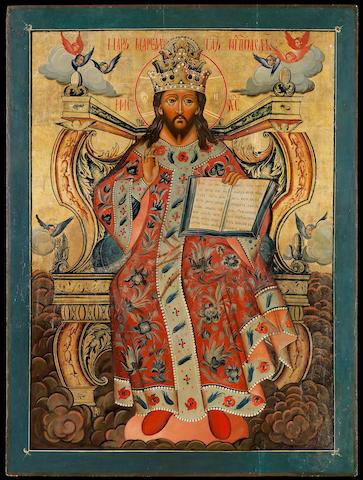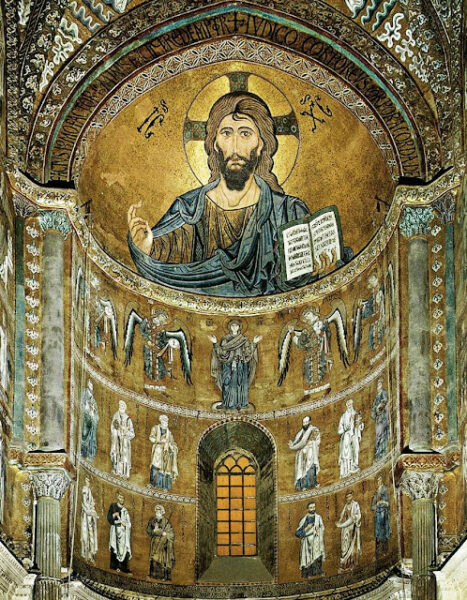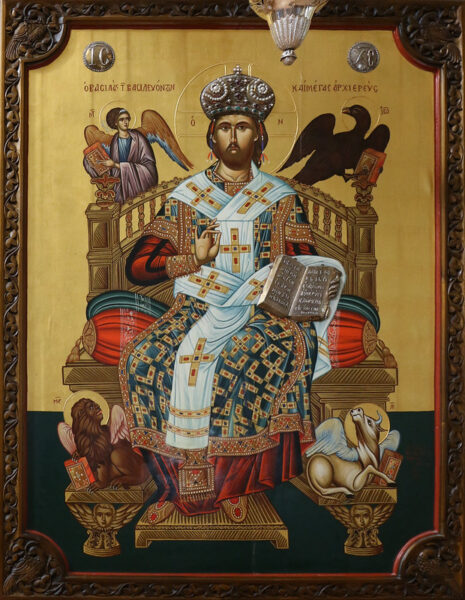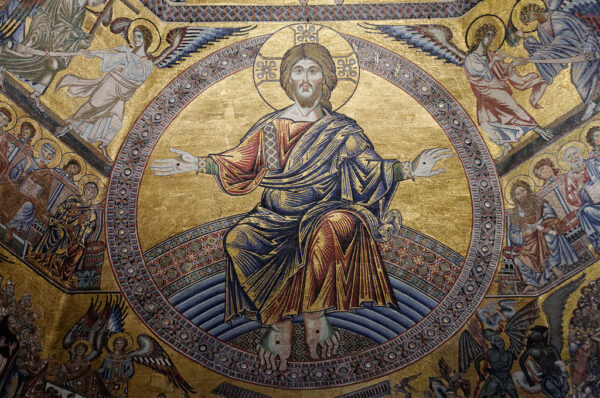 I wrote a blog post about the O Antiphons in 2019, and I loved picking out the image to illustrate each one. So I have decided to post on the O Antiphons again, in order to highlight additional images and to explore the scriptural roots of the meaningful word images. If you aren’t familiar with the O Antiphons or need a refresher, please check out my 2019 blog post here.
I wrote a blog post about the O Antiphons in 2019, and I loved picking out the image to illustrate each one. So I have decided to post on the O Antiphons again, in order to highlight additional images and to explore the scriptural roots of the meaningful word images. If you aren’t familiar with the O Antiphons or need a refresher, please check out my 2019 blog post here.
Today we pray the sixth O Antiphon out of the last seven days before Christmas, in these late days of Advent intensification. We are now just two days away from the Christmas vigil and our longing for the coming of Jesus continues to escalate.
Are you moving into a balanced situation instead of rushing around getting ready for Christmas? Remember that reciting the words of the O Antiphon for each day takes less than a minute. You can easily include them before and after grace at dinner or as part of your advent wreath tradition. Just slowing down a bit should promote a sense of presence that will help you find and be present to those shimmering moments that are embedded in the season. And if you take just another less than a minute to light a candle or your advent wreath beforehand, I promise the O Antiphons are breathtaking by candlelight!
You can find my blog post on the O Oriens antiphon from yesterday here and the blog post on the O Emmanuel antiphon for tomorrow, here.
O Rex Gentium – Antiphon for December 22
O Rex Gentium, Ruler of Nations and their desire, the cornerstone binding two into one: come and save the human race, which you fashioned from clay.
O Rex Gentium, et desideratus earum, lapisque angularis, qui facis utraque unum: veni et salva hominem, quem de limo formasti.
O Ruler of Nations and their desire:
Come to me heedfully. Listen that you may have life. I will renew with you the everlasting covenant, the benefits assured to David. As I made him a witness to the peoples, a leader and commander of nations. (Isaiah 55:3-4)
The Messianic title “Ruler of Nations” has been traditionally translated as “King of kings.” In the first letter of Paul to Timothy quoted below, we see this title explictly linked to Jesus. Note that the alternate title uses the plural “nations” to indicate that the mission of the Messiah was not to one nation alone. Jesus came to save both Jews and Gentiles. Paul writes to Timothy:
I charge you to keep God’s command without blame or reproach, until our Lord Jesus Christ shall appear. This appearance, God will bring to pass at the chosen time. [Christ] is the blessed and only ruler, the King of kings and Lord of lords who alone has immortality and who dwells in unapproachable light, whom no human being has ever seen or can see. To [Christ] be honor and everlasting rule! Amen. (1 Timothy 6: 14-15)
It’s not coincidental that the title Ruler of Nations is also mentioned in John’s book of Revelation, cited below. Immediately following the ascension of Jesus, His disciples were preaching the Gospel widely, with the expectation that the second coming of Christ would be very soon. The prophesies of the “end times” from Isaiah were also echoed in Revelation, as the idea that Jesus Christ would return to earth as the final Judge of all.
The heavens were opened, and as I looked on, a white horse appeared. It’s rider was called “The Faithful and True.” Justice is his standard in passing judgement and in waging war. his eyes blazed like fire, and on his head were many diadems. Inscribed on his person was a name known to no one but himself. He wore a cloak that had been dipped in blood, and his name was the Word of God. The armies of heaven were behind him, riding white horses and dressed in fine linen, pure and white. Out of his mouth came a sharp sword for striking down the nations. He will rule with an iron rod; it is he who will tread out in the winepress the blazing wrath of God the Almighty. A name was written on the part of the cloak that covered his thigh: “King of kings and Lord of lords.” (Revelation 19:11-16)
In the Old Testament, the Israelites cherished Yahweh’s promises and waited for their fulfillment. However, in the New Testament and now today, we frequently forget that we must wait, sometimes in painful frustration, for the promise of healing and wholeness to be revealed. In the meantime, we see that racism, xenophobia, misogyny, mass shootings, homophobia, hate crimes, and violence of all kinds fill the news. We are told that Jesus came to save us “in the fullness of time,” and so we must work for justice and equality, even as we continue to wait for the attainment of freedom and unity that is promised in the following verses from Galatians:
All of you have been baptized into Christ, have clothed yourselves with him. There does not exist among you Jew or Greek, slave or freeman, male or female. All are one in Christ Jesus. Furthermore, if you belong to Christ, you are the descendents of Abraham, which menans you inherit all that was promised. (Galatians 3:27-29)
The cornerstone binding two into one:
The Messianic title of Ruler of Nations is also qualified as being the cornerstone for the structure of life. The cornerstone image is connected to the ancient quarries, where stones were selected and cut to size. The stones used for construction were chosen carefully, so that the foundation of the structure to be built would not be compromised. The cornerstone was the first stone to be laid in a construction and had to be cut with incredible precision, in order to be straight enough, so that the resultant building would not be off center or out of line. This following verse from Isaiah, that prefigures the birth of Jesus, acknowledges that a precisely cut cornerstone is precious:
Thus says the Lord God: “See, I am laying a stone in Zion, a stone that has been tested, a precious cornerstone as a sure foundation. You who put your faith in it shall not be shaken. (Isaiah 28:16)
And in Psalm 118, we first see the statement that the rejected stone was to become the cornerstone:
The stone which the builders rejected has become the cornerstone. By the Lord has this been done; it is wonderful in our eyes. (Psalm 118:22-23)
Highly-trained stonemasons rejected many stones before finding one that was strong enough and straight enough to be used as the cornerstone for their structures. It was possible to use rejected stones for other purposes or for other parts of the building being built, but a stonemason would never use them for cornerstones. In some structures, a quality cornerstone may be especially important, for example if the orientation and direction of the building required astronomical precision.
 So what does it mean that a rejected stone could be used for the cornerstone? In Matthew 21:42, Mark 12:10-11, and Luke 20:17, we hear that Jesus is the rejected stone that has become the cornerstone. He was rejected by many Jewish authorities, but He became the cornerstone for Christianity. This language of rejection is also used by Luke in the following excerpt from the Acts of the Apostles:
So what does it mean that a rejected stone could be used for the cornerstone? In Matthew 21:42, Mark 12:10-11, and Luke 20:17, we hear that Jesus is the rejected stone that has become the cornerstone. He was rejected by many Jewish authorities, but He became the cornerstone for Christianity. This language of rejection is also used by Luke in the following excerpt from the Acts of the Apostles:
[Peter said,] “This Jesus is the stone rejected by you, the builders, which has become the cornerstone. There is no salvation in anyone else, for there is no other name in the whole world given to humans by which we are to be saved.” (Acts 4:11-12)
The phrase “binding two into one,” directly pertains to the mission of Jesus. He extended salvation, not just to the Jewish people, but to the Gentiles as well. It seems to me that Jesus is always trying to connect and bind us to to one another and to the Trinity through Himself, using the ordering spirit/mechanism of Holy Wisdom. This is described in the following verses from the Gospel of John:
[Jesus prayed to Abba], “As you have sent me into the world, so have I sent [my disciples] into the world. I consecrate myself for their sakes now, that they may be consecrated in truth. I do not pray for them alone. I pray also for those who will believe in me through their word, that all may be one, as you Abba are in me and I in you. I pray that they may be one in us that the world may believe that you sent me.” (John 17:18-21)
Come and save the human race, which you fashioned from clay.
There are a few scriptural references to being fashioned from clay. Of course there is the story of the creation of Adam in the book of Genesis, and then there is this verse from Isaiah:
Yet, O Lord, you are our father: we are the clay, and you the potter; we all are the work of your hands. (Isaiah 64:8)
There is also this longer passage from Jeremiah, indicating that Yahweh formed and re-formed the House of Israel, working the clay to fashion and re-fashion the community according to God’s own hidden and sacred designs:
This word came to Jeremiah from the Lord, “Rise up and be off to the potter’s house. There I will give you my message.” I went down to the potter’s house and there was the potter, working at the wheel. Whenever the object of clay which he was making turned out badly in his hand, he tried again, making of the clay another object of whatever sort he pleased. Then, the word of the Lord came to me, “Can I not do to you, house of Israel, as this potter has done? Indeed, like clay in the hands of the potter, so are you in my hand, house of Israel.” (Jeremiah 18:1-6)
I was interested to discover that the Latin word “limo,” in the O Antiphon, which is translated here as “clay,” conveys a sense of “mud, slime, or mire.” Good thing God doesn’t worry about getting God’s hands dirty.
We definitely need Jesus to come and save the human race! We are not behaving like a responsible species lately. On this next to the last day of the O Antiphons, as we ourselves have been formed and re-formed by our Potter God, we impatiently look for the Messiah to come now quickly – do not delay!
As a reminder, there are a couple of options if you are interested in hearing the O Antiphons chanted in Latin. First, if you click here you will go to the Traditional Catholic Living website (Reference 5) that has a link to each O Antiphon, with the words and music so that you can follow and chant along. You can also find the chants here at an LDS blogpost (Reference 6.) I like this link, because it includes the entire vespers sequence. Each O Antiphon is chanted, followed by the Magnificat, finishing with the O Antiphon chanted again.
In my opinion, listening to the Gregorian chanting by candlelight is the best way to experience the O Antiphons!
Readings: The New American Bible, Confraternity of Christian Doctrine, Washington DC, 1970.
Reference 1: Malcolm Guite, “O Rex Gentium a Sixth Advent Reflection,” blog post, December 20, 2021.
Reference 2: Ives Digory, O Rex Gentium: Meditations on the O Antiphons, blog post at Sanctum in Heremis website, January 11, 2015.
Reference 3: O King, Mount Saint Mary’s Cistercian Abbey, Wrentham, MA, December 22, 2018.
Reference 4: Br. Jerome OSB, “Reflections on the O Antiphons,” blog post at https://liturgy.co.nz/reflection/oantr2.html, 2011.
Reference 5: Sing the O Antiphons Gregorian Chant, Traditional Catholic Living website, http://www.traditionalcatholicliving.com/o-antiphons-advent/.
Reference 6: Awaiting the Coming Messiah: The “O Antiphons,” LDS Seasonal Materials, http://huntsmanseasonal.blogspot.com/2013/12/awaiting-coming-messiah-o-anitiphons.html.
Image 1: Christ the King of Kings, Orthodox icon in style of Vasily Rostchin, Kostroma, mid-18th century.
Image 2: Christ the Eternal High Priest, icon at Saint Anthony’s Greek Orthodox in Arizona, photograph by Fr. Lawrence Lew OP, flickr.com, January 2, 2019.
Image 3: Byzatine Apse Mosaic, Cefalu Cathedral in Sicily, Italy, 1148.
Image 4: Christ in Majesty, 13th-century ceiling mosaic, Battistero di San Giovanni (Saint John’s Baptistry,) Florence, Italy.

















Leave a Reply
Join the conversation by submitting a comment to this blog post below.